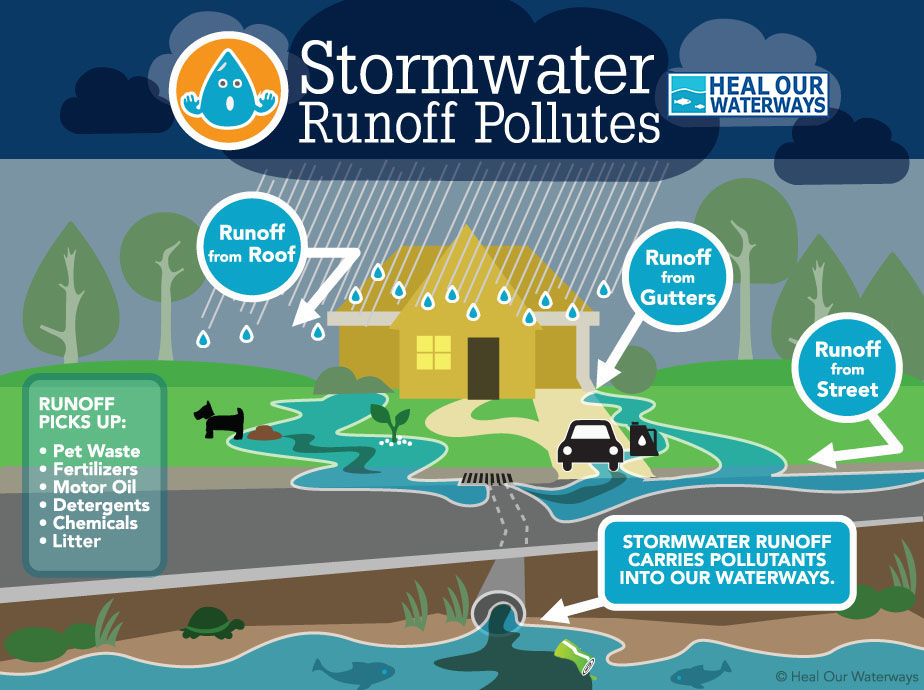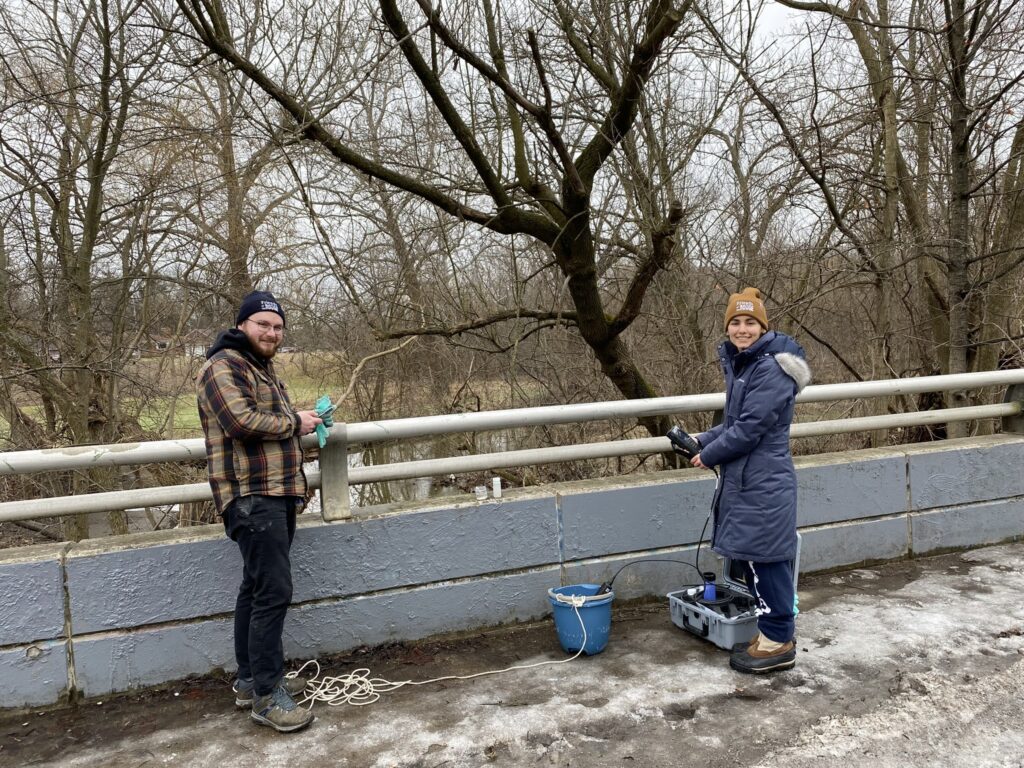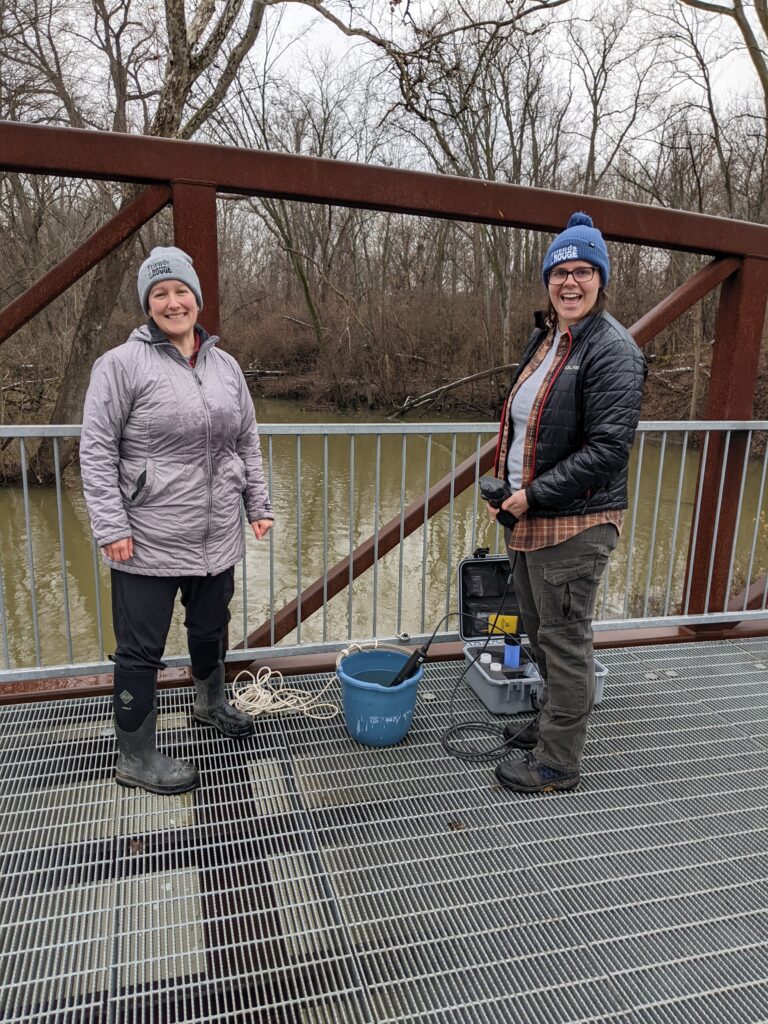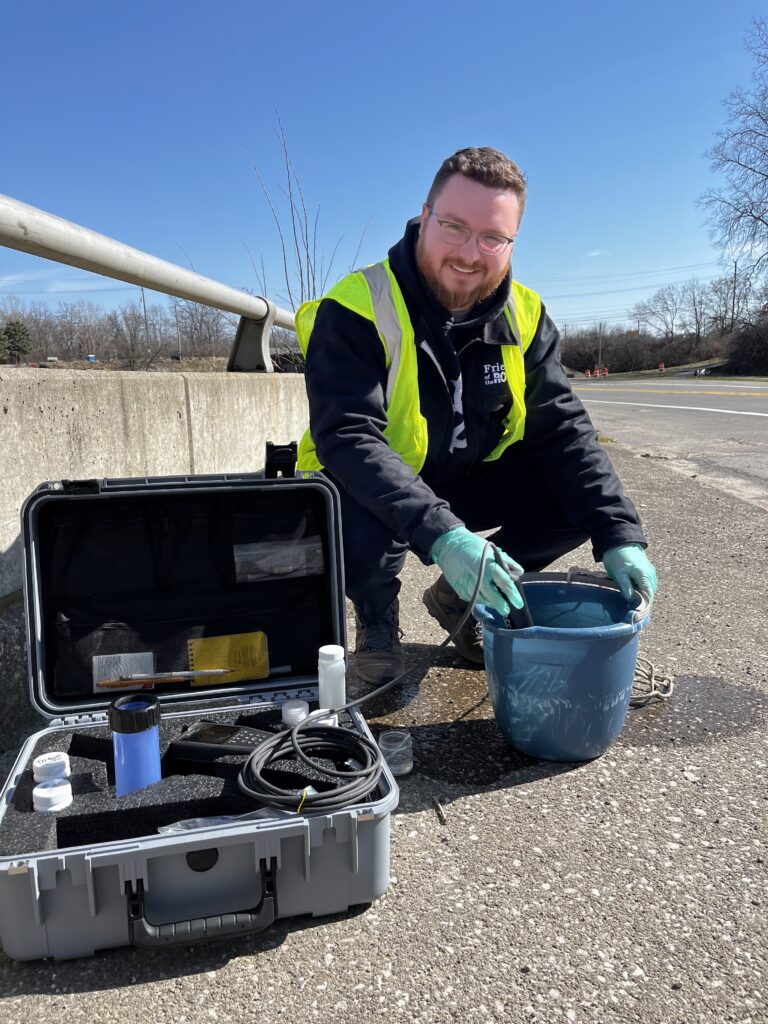The Rouge River has one of the most urbanized watersheds in the country. This means most of the pollutants come from storm water pollution. This is nonpoint source pollution, meaning that rainfall or snowmelt carry unwanted substances to our river. One major thing that emerges from this storm water: chloride (salt). Road salts directly run off into the Rouge. Excessive use can bring detrimental effects to the environment. Recently, there has been an increased use of road salts. This leads to more issues for the watershed.
Chloride harms the freshwater organisms that live in the river, from the fish to the frogs. They suffer from the toxicity since these species are not meant to live in high salinity habitats. Read more about the effects chloride has on our water-bound friends.

It is Friends of the Rouge’s responsibility to strive for outstanding stewardship. In 2020, a chloride initiative was launched and the results from 2024 were published earlier this year. In 2019, the Michigan Department of Environment, Great Lakes, and Energy (EGLE) set standards for chloride in Michigan. But, knowledge about chloride concentration throughout the Rouge watershed is not complete.
FOTR tested 39 sites across the watershed that were chosen based on the Assessment Unit ID (AUID). There are 4 major branches, 17 subwatersheds and 36 AUIDs in the Rouge River watershed. Friends of the Rouge has collected data from all 17 subwatersheds. 35 of the 39 sites we sampled had high levels of chloride. We strived to choose sites where previous data from Friends of the Rouge had both high and low chloride. We also aim for sites that have not been sampled or rarely sampled before.
Additionally, we included several data collection methods to measure accuracy of volunteer data. Specifically, we were seeing if the salt test strips were as useful as the other equipment. This widespread coverage helped to develop correlation curves to compare different sampling methods. We found that the salt test strips are an easy-to-use, affordable method that produces accurate data. This is great news because other volunteer groups could use the salt test strips for their data collection.
What We Do

Read the full 2024 Quality Assurance Project Plan assembled by FOTR here. This was required by EGLE to complete the project.
Our chloride monitoring goals
- January to June 2024: collection at 39 sites throughout the Rouge watershed
- Method comparison: salt test strips, chloride sensor, conductivity sensor, and laboratory analysis
- Build on existing FOTR chloride data
- Create usable maps from findings
- Submit report to EGLE, Friends of the Rouge Monitoring Committee, and other partners
- Identification of polluted areas and long term water quality improvement
Methods and Equipment
Starting in 2020, Friends of the Rouge has been collecting data on chloride levels. This was done with Hach Chloride QuanTab (salt) test strips provided by Izaak Walton League. These were given as part of their Salt Watch Program which gathers volunteer chloride data. We brought the salt strips to the benthic monitoring program events. You might’ve seen them at the Spring and Fall Bug Hunts. Team members rinse a clean cup with river water three times. Then, the end of a strip is submerged in 1 inch of water. After the orange line at the top turns dark blue or black, the salt strip will have a white streak. This indicates the salt concentration in parts per million (ppm) based on the peak. This is found from an accompanying conversion chart.

A YSI ProDSS water quality probe measured physical elements. These included chloride, conductivity, and water temperature. Samples were collected using a bucket attached to a rope or using a pole sampler. Before collecting the sample, the bucket was rinsed three times with water. Water from the bucket was poured into the sample bottle. The physical parameters were measured from the water remaining in the bucket. This was immediately done to ensure accurate readings. In cases when the river was frozen, the ice was broken and a water sample was taken.
Analysis and water sample jars were provided by Brighton Analytical, which is an EGLE approved laboratory. The bottles were rinsed 3 times at the site with water from the stream before sample collection. The samples were kept in a cooler with ice, then kept in a refrigerator, then transported to Brighton Analytical within 28 days.
Data was recorded in an ArcGIS Survey123 Form that FOTR developed and used in the field. Samples were collected 4 times per site. This frequency is based on the 2022 Integrated Report. Two of the sample collections were wet events and two were dry events.
Date, location, weather, salt test strip reading, conductivity reading, chloride reading, and temperature were collected at each site. At the weather station, wet events were recorded as “0.5 inches of rain over 24 hours or 0.25” of rain over 12 hours.”
Findings
After collection and analysis, FOTR found that 35 out of the 39 sites had levels that were toxic to aquatic life. This means that 1 of the samples exceeded the AMV (320 ppm) OR more than one of the samples exceeding the FCV (150 ppm). There were 12 times when the salt test strip reading was higher than the max value on the strip (greater than 641 ppm). Those 12 readings were removed from the data set, as there was no way to know if the true reading was far higher.
The only sites not polluted with chloride, according to EGLE’s criteria, are two in Johnson Creek, one in the Lower Rouge, and another in Fowler Creek. This can be used to guide decisions about future monitoring and pollution source identification.
Click here to launch map in a new tab
Another goal of the study was to define the accuracy of volunteer-gathered data. At levels below 641 ppm, the results from the test strips were extremely reliable. The relationship between the salt strips and the laboratory analysis was almost one-to-one (see graph below). We also found the YSI conductivity sensor to be a good measure of chloride compared to the laboratory analysis. We had no technical issues with the conductivity sensor. However, the YSI chloride sensor was not reliable. It failed to stabilize and provide a consistent reading, even after sensor replacement. Because of this, we would not recommend using a chloride sensor to track chloride levels.

All of this was sent to EGLE for use in the upcoming 2026 Integrated Report for evaluating designated uses.
Recommendations
The comparison revealed that the salt test strips and the YSI conductivity sensor are reliable ways to measure chloride. The strips are an easy-to-use, relatively cost effective method. These could be easily used in a volunteer program and could be a reliable screening method for regulatory agencies. The Izaak Walton League offers a small number of free test strips for groups willing to submit their data to the Salt Watch Program. Hach offers high range test strips that could be added for use at sites with values above 641 ppm. These are favored over the conductivity sensor due to the high cost, calibration needs, and replacement of sensors. This would be hard for a volunteer group with a small budget.

Friends of the Rouge participates with the Michigan Clean Water Corps (MiCorps). It is a statewide organization that assists EGLE with water quality data. MiCorps is best situated to integrate test strips into their monitoring programs. They already have volunteers collecting other water quality data using standardized protocols. FOTR found that the test strip procedure was a simple task for volunteers to add when they are in the field. The data is important for groups concerned about water quality, from local organizations all the way up to the state level.
Since high levels of chloride were found across the watershed, our guidance would be to address upstream areas first. This should especially be those with GOOD Stream Quality Index Scores for the benthic communities. Minnow Pond and Pebble Creek are two examples of this. Upstream areas have fewer inputs, which makes it easier to find the source of the chloride. Downstream areas have many streams and inputs that have been combined. We also recommend examining upstream AUIDs that exceeded the State Maximum Value (320 ppm) for chloride.
Many upstream Rouge municipalities are already incorporating anti-icing Best Management Practices (BMPs). It could be very good for a city to encourage private companies to incorporate BMPs under the municipal guidance. These companies could reduce salt usage and thus improve water quality. For example, the Road Commission for Oakland County has already used some BMPs in their salt trucks (read the fact sheet). Also, the City of Farmington Hills has incorporated many BMPs for anti-icing. Other useful BMPs could be using brine or pre-wetting rock salt, better salt storage methods, salt spreading rate on trucks, and road salt clean up from sidewalks. One study found an average reduction of 45% chloride loading to streams when brining was used by cities.
It is crucial to focus on the best management guidelines on private residential and commercial salt application. One study found that medium-to-high density development was strongly related to salt in streams. The amount of salt in a stream is related to how populated an area is. To encourage the use of BMPs by these targeted salt users, Michigan could offer a voluntary Winter Salt Certification Program. Similar to the one in Wisconsin, snowplow drivers and contractors could learn and follow the BMPs (Wisconsin Salt Wise). Those private companies could be added to a certified salt applicator list that could be promoted throughout our state. There is a downloadable list of certified salt applicators that can be found on this website.
There are still other other things that could be done to encourage and/or mandate BMPs to mitigate salt impacts on the environment. For example, EGLE could explore phytoremediation regulation on existing and future stormwater ponds. Snodgrass et al. 2017 found very high sodium and chloride levels in the groundwater beneath stormwater ponds. Also, year-round groundwater plumes spread to streams from these sources. Through this project, we found high levels of chloride in the Rouge River throughout the year. It is reasonable to consider that the stormwater ponds in the watershed could be acting as chloride reservoirs. These could be contributing to declined groundwater quality over time. Native grasses such as Switch grass (Panicum virgatum), Sand Dropseed (Sporobolus cryptandrus), Prairie Cord Grass (Sporobolus michauxianus), and Side-Oats Grama (Bouteloua curtipendula) are effective at removing salt from the soil. Grasses like these could be planted as a buffer around stormwater ponds. This could help reduce groundwater concentration and salt spread to the river during the whole year.
Your Turn
Even though specialized equipment was used in our monitoring process, that does not mean it is necessary to make a change. Every action is part of a larger effort to keep the Rouge healthy. Wondering what you can do to help the watershed from dangerous chloride levels? We created a helpful post all about de-icers and how to take charge in your neighborhood! There is also information from Izaak Walton League of America Salt Watch on spreading awareness.

Categories
-
Category Name 5Short description about the category for context.



